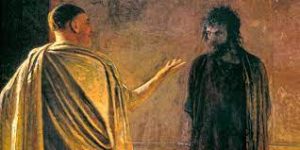The Civil Trial
Pilate was Roman, and Caiaphas was Jewish. They worshiped different deities, ate different foods, had different hopes for their future, and spoke different languages. Pilate served at the will of a supposedly divine emperor, while Caiaphas supposedly served at the will of ADONAI. They both shared a command of the Greek language and a belief that they were entitled to do anything to stay in power.

That being said, in the final analysis, nothing happened without the approval of Pontius Pilate, the Roman procurator (Perseus: Tacitus, a Roman senator, The Annals Book XV, 62-65 AD, 15.44). As if a symbolic reminder, Pilate held the clothing of the high priest (see my commentary on Exodus, to see link click Fw – The Clothing of the Levitical Priesthood) in an ornate chest at Fortress Antonia. Under Roman control, Pilate unlocked them on the morning before high holy days and gave them to Caiaphas with the understanding that he would return them to Pilate after the Festival of Unleavened Bread and the Passover were over.
The civil trial took place in the former palace of Herod the Great, then called the praetorium, the headquarters of Pontius Pilate (Matthew 27:27; John 18:28 and 33). In time of peace one of the best buildings of any city were selected for the residence of the procurator. Thus, in Jerusalem he took up residence in the praetorium. It was big and lavish and the courts were trimmed with alabaster. This was the most exclusive section of Jerusalem and Pilate was accustomed to the size and comfort of such a royal palace, not the stark military conditions of Fort Antonia. He commanded the Roman soldiers in Jerusalem, but he did not live with them. Plus, his wife had accompanied him. Would he have her tolerate her visit among rough and tumble Roman soldiers? Never!
The statements of Josephus make it almost certain that the headquarters of the procurator were at Herod’s palace. This was a building whose magnificence Josephus can hardly sufficiently appraise (Wars, I, xxi, 1; V, iv, 4). It was in this palace that “Florus, the procurator took up his quarters, and having placed his tribunal in front of it, held his sessions and the chief priests, influential persons and notables of the city appeared before the tribunal” (Wars II, xiv, 8). Later on, “Florus . . . brought such as were with him out of the king’s palace, and would have compelled them to get as far as the citadel (Antonia); but his attempt failed” (II, xv, 5). The soldiers led Jesus away within the palace (that is, the praetorium).
The actual site of the praetorium cannot have been far removed from three Hasmonean towers: the Tower of Hippicus, the Tower of Phasael and the Tower of Mariamne. Byzantine Christians in the fifth century eventually replaced them with a much larger, more massive tower, today called the Tower of David. They borrowed the name from the Song of Songs, attributed to King Solomon, King David’s father, who wrote: Your neck is like the tower of David, built with courses of stone; on it hang a thousand shields, all of them shields of warriors (Song of Songs 4:4).
It is interesting to note that for many years two stations of Turkish garrison occupied the same spot as did the Roman garrison of Christ’s time. In 2011 the old Turkish prison built by the Ottoman Turks in the mid 1800s opened briefly. It sits next to the Tower of David. It is needless to point out how much this more recent information about the praetorium must modify the traditional claims of the “Via Dolorosa,” the whole course of which depends on the false theory that the “Way of Sorrow” began at Fort Antonia.



Leave A Comment